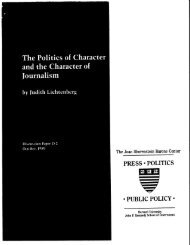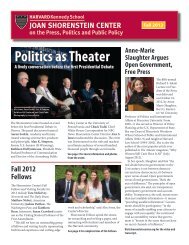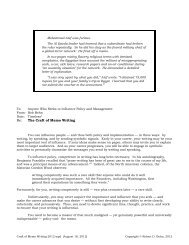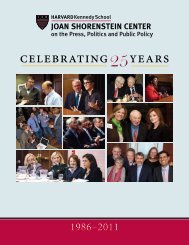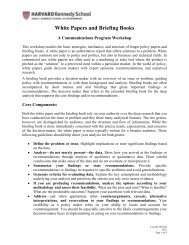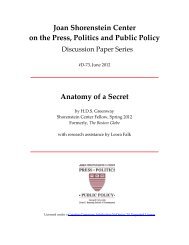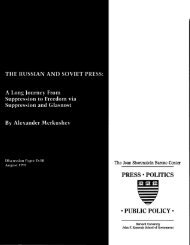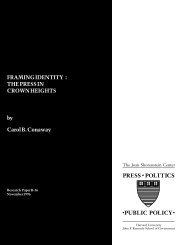Why Paper Is Eternal - Joan Shorenstein Center on the Press ...
Why Paper Is Eternal - Joan Shorenstein Center on the Press ...
Why Paper Is Eternal - Joan Shorenstein Center on the Press ...
You also want an ePaper? Increase the reach of your titles
YUMPU automatically turns print PDFs into web optimized ePapers that Google loves.
do understand what a document c<strong>on</strong>veys by physically getting to grips with it.<br />
Given this, <strong>the</strong> limits of electr<strong>on</strong>ic alternatives (at <strong>the</strong> current time at least) are<br />
all too clear.” 61<br />
Still, this doesn’t fully explain how paper fosters <strong>the</strong> state of focused<br />
reading that <strong>the</strong> IMF employee described. Indeed, Sellen and Harper’s book<br />
often suggests that paper is at its best when <strong>on</strong>e is juggling different documents<br />
and functi<strong>on</strong>s – say, writing, editing and reading – a mode that seems closer to<br />
multi-tasking than settling down. However, <strong>the</strong>se two noti<strong>on</strong>s are not as<br />
c<strong>on</strong>tradictory as <strong>the</strong>y seem. Ra<strong>the</strong>r, within a multi-tasking c<strong>on</strong>text, printed<br />
documents make it easier to focus <strong>on</strong> each specific task, and to carry that focus<br />
from task to task. In o<strong>the</strong>r words, though <strong>the</strong> computer is in some ways <strong>the</strong><br />
ultimate multi-tasking tool – everything is a click away – for productive multi-<br />
tasking, paper has an edge, rooted in its tangibility. Because <strong>on</strong>line documents<br />
have no physical presence, when we’re reading <strong>the</strong>m <strong>the</strong> eyes and <strong>the</strong> brain are<br />
c<strong>on</strong>stantly at work figuring out where we are in <strong>the</strong> text, not just <strong>on</strong> <strong>the</strong> page<br />
displayed but in <strong>the</strong> document as a whole and vis-à-vis o<strong>the</strong>r open documents,<br />
as well as where we need to go next. The <strong>on</strong>line reader expends a great deal of<br />
mental energy just navigating. <str<strong>on</strong>g>Paper</str<strong>on</strong>g>’s tangibility allows <strong>the</strong> hands and fingers to<br />
take over much of <strong>the</strong> navigati<strong>on</strong>al burden, freeing up <strong>the</strong> brain to think.<br />
Sellen and Harper describe how this works:<br />
“[T]he physical feel of <strong>the</strong> paper meant that little attenti<strong>on</strong><br />
(and especially visual attenti<strong>on</strong>) had to be given over to <strong>the</strong><br />
task of page turning. Much of <strong>the</strong> informati<strong>on</strong> needed to<br />
navigate was both implicit and tactile. Similarly, physical cues<br />
such as thickness of <strong>the</strong> document provided important tacit<br />
informati<strong>on</strong> about where in <strong>the</strong> document <strong>the</strong> reader was. All<br />
38



